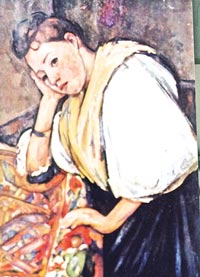The French impressionists
 I have never understood the word ‘impressionist’ in art whether it is
French, Italian or British impressionist. They all make a complicated
picture in my mind. When my art teacher introduced the ‘impressionist’,
all I thought was of an artist who made an impression which boils down
to any artist who would naturally make an impression, good or bad. I may
be right or wrong but the word has not left my mind ever since I threw
away my brush. I have never understood the word ‘impressionist’ in art whether it is
French, Italian or British impressionist. They all make a complicated
picture in my mind. When my art teacher introduced the ‘impressionist’,
all I thought was of an artist who made an impression which boils down
to any artist who would naturally make an impression, good or bad. I may
be right or wrong but the word has not left my mind ever since I threw
away my brush.
French Impressionists are the most imposing among the lot because
their clang consists of the Masters such as Degas, Pissarro, Renoir,
Manet, Monet, Sisley etc. and they all painted admirable impressionist
pictures; but the question remains. What else had they in common? (Can
my colleague Tissa Hewavitharana answer that?)
However, they discovered an essentially a passionate delight in
rediscovering paganism which had fired their imagination.
Rubbish; I think they lacked the technique consistency of the
Italians but the French went beyond their inspiration. They never went
into history nor mythology like the Italians. The French Impressionists
were hardly sentimental about religious painting and at times sounded
dreadful. Even on a flying visit to Paris Louvre some years back, I did
not change my mind. Parisian pictures are purely impressionist in
technique and spirit.
|

‘Italian Girl’ by Paul Cezanne - 1896 Oil on canvas - 36 x 25
3/8 in New York with the H Bakwin collection |
So much so, for the French masters.
Sisley born to English parents is probably the least admired though
he was an exquisite French painter. When he was in London with Monet and
together they discovered Turner and Constable, one would imagine that
they were a part in the formation of the Impressionism. But by 1877
Cezanne was dreaming of making impressionism true.
Prior to that no critic recognised the works of Cezanne even though
in Paris with his benevolent acquaintance with Pissaro. To begin with
when the doctrine and technique were being elaborated, these masters had
already given proof talent in good painting. I have never seen a
scientifically impressionist painting by Cezanne though many art critics
claim he did.
I never saw such paintings at the Louvre. As I keep discovering these
unholy pictures (I never liked the impressionists) I find that Degas is
not one of them though he is listed in this category. Even Renoir was
hardly an impressionist but he was a genius among the lot. So, why call
him an Impressionist? Degas paintings have been attributed to the study
of instantaneous photography.
So what? If a painter cannot store in his mind what he had seen and
wished to paint the subject, the best bet is photography. I know of a
very talented artist in Sri Lanka who use this method. I have seen an
artist exhibiting a painting very similar to the ‘Liberty leading the
people’ at the Lionel Wendt. This magnificent masterpiece by Delacroix
was inspired by ‘The French Revolution’. I saw it at the Paris Louvre.
Most impressionists favoured the theme of passion and figures,
especially women and nude. They approached the subjects with startling
boldness. Some were exciting and inspired by poetry.
As colour became the prime importance, they would use pastels for
developing the drawings and later move on to oils, but the use of colour
and light were purely individualistic.
The spirit of impressionism bound them together and none deviated
from its objective. They were obsessed with their own sensual
experiences and less preoccupied.
Renoir’s ability to achieve almost photographic realism in his
painting gave him the impetus to build his reputation that was
challenging to the rest of the Impressionists. It all rested on his
ability to create phenomenal drawing to execute the vigorous emphatic
medium - the oils.
His paintings were creative by far and large and the ability to
capture a likeness very quickly. His compositions became simple as he
worked upon painted surface wit meticulous accuracy.
Renoir was a figurative artist like most of this colleagues who found
it difficult to break away from tradition and locked upon within its
boundaries. How unlike the case of Pissarro who had a strong inquisitive
mind that made him a born explorer. Unlike the rest, he was not an
Impressionist every day. He broke the rules of the old school with his
taste for experiment.
|



